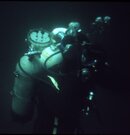Well, I'd like to just say that I'm not advocating that anyone do the testing I described previously. It was more of a point of how hard it is to get accurate data on swimming efficiency of a diver. It's near impossible! ...
...The load cell experiment described above only tests static thrust performance. Divers are moving when they swim. It is testing a non-operational performance characteristic of the device. It is possible to track total body caloric expenditure if you can measure the O2 and CO2 flux, but how do you get that data without the diver dragging hoses along for the ride to deliver the gases to a machine to make the measurements; again, the thing you are trying to measure has been altered by the attempt to make the measurement.
I participated in a study by two fellows, Joe Russel and Alex McNeill, who were doing physiological experiments on divers for their Ph.D. in Exercise Physiology from the University of Oregon (Joe transferred to the U of C Institute of Environmental Stress shortly thereafter). This was in 1970 when I dove in Clear Lake, Oregon. I came home from the USAF and dove these experiments on June 14 and June 16, 1971. (At the time of these dives, I was only days out of DaNang, RVN after my discharge.) You can see my dive log for these dives. But what was interesting is that they took my EKG, pulse, and respiration rate, and sampled my exhaled breath using a vacuum tank as I swam a horizontal line at various depths. This is one method that data could be collected, and was on one occasion, concerning fin usage.
Dan,
I dove today with my Dacor Nautilus CVS and with my Force Fins (the originals). You are correct that the kick needs to be modified to use these fins. The "kick shape," as you describe it, is much different as the original Force Fins do not have any "heft" on the up-kick at all. I found them to be good when I was submerged if I practiced a "kick shape" that emphasized the down-kick, hard, and de-emphasized the up-kick. When hovering, I was able to maneuver pretty well around a wreck of an SUV in my small dive site on the Clackamas River. The frog kick, which I tried in two ways, had mixed results. If I kicked the traditional breaststroker's frog kick, with the bottom of my feet, the Force Fins collapsed and provided very little kick force. But if I turned my foot over, and did the frog kick with the top of my feet (which is weird for a former competitive breaststroker), they worked well. On the surface, because it is difficult to impossible to put the down kick in the correct position, they were harder than my fins ("scoop fins," which I have not yet identified here). One of the foot straps had come loose, and was under my heel, but that made no difference as these fins tend to stay on even without the fin strap (they push upwards on the foot pock, rather than sliding off).
I actually have three of these Force Fins (original), and am hoping to get my hands on a fourth. If I do that, then I'll take one of the pairs and remove the foot pocket, then bolt them onto the underside of the other set to see how they perform together. That way, I would have both the up-stroke and down-stroke to work with. Has anyone thought of that? It would mimic the way some seals swim, with their hind fins collapsing on one side and the other side taking the stroke, then the reverse process happening. That would make it rather difficult to walk with these fins, though.
John








